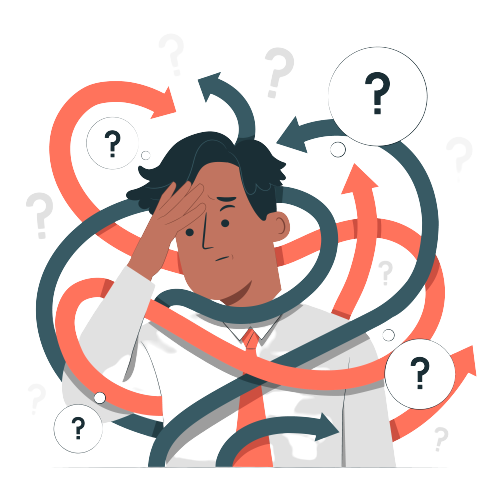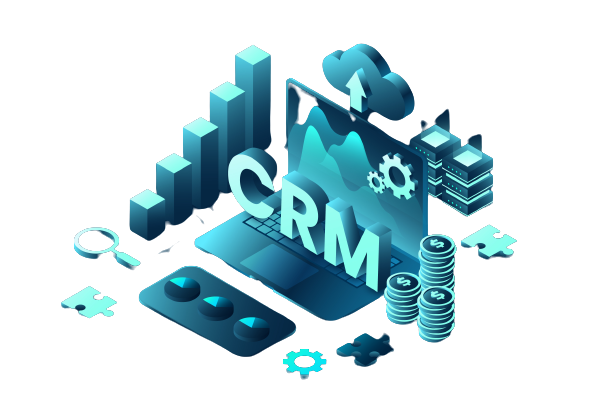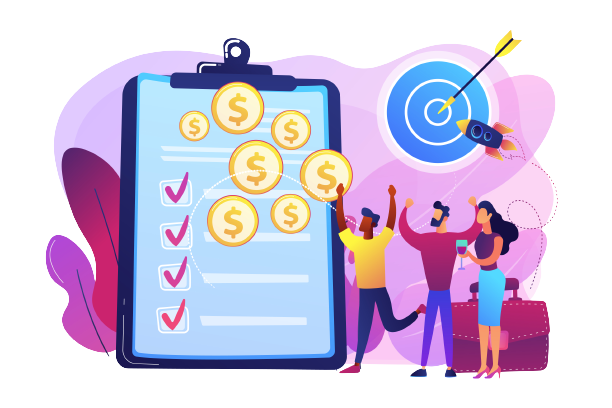
Mastering the art of navigating complex sales cycles has become a cornerstone of success for companies big and small. But fear not, as there’s a solution that can transform the way businesses manage these convoluted paths, i.e. CRM workflow automation.
CRM software makes everything work perfectly. Different tasks, like taking care of potential customers, sending messages at the right time, and understanding important information, all come together smoothly if you choose the right CRM solution as it can automatically take care of many things, making any business even more powerful.
In this blog, we’re going on a journey of tricky sales processes. We’ll see how a special tool called CRM workflow automation acts like a helpful guide, leading sales teams through tough situations in a smart and efficient way. Whether you’ve been doing sales for a long time, you’re a curious business owner, or you just want to know how successful sales work, this adventure will show you how to make things simpler.
We’ll talk about the problems that often show up when doing complex business-to-business sales. We’ll also look closely at the important steps that make up these complicated sales cycles. And the best part is, we’ll learn about how CRM workflow automation comes in to change the game. We’ll learn about why automation is important and all the good things it brings.
So, whether you’re enjoying your morning drink, taking a break from work meetings, or trying to find ways to enhance your business strategies, continue reading this blog. By the end, you’ll understand how technology and smart strategy can reshape the way businesses approach complex sales cycles. This will make things easier and more rewarding. Let’s jump in and see how CRM workflow automation can make complex sales processes simpler and better.
Deconstructing Complex Sales Cycles: A Comprehensive Overview

Navigating complex sales cycles requires a profound understanding of the intricate dance between businesses and their prospective clients. In this comprehensive overview, we delve into the intricacies of complex sales cycles, shedding light on the various components that contribute to their multifaceted nature.
At its core, a complex sales cycle involves a series of interconnected steps that a business undertakes to transform a lead into a loyal customer. Unlike simple transactions, complex sales cycles are characterized by longer timelines, multiple decision-makers, and a need for relationship-building. From initial contact to final conversion, each stage plays a crucial role in orchestrating a successful deal.
Challenges and Roadblocks in Complex B2B Sales Processes

The world of complex B2B sales processes is not without its challenges. Enterprises engaged in these cycles often face an array of roadblocks that demand strategic finesse and innovative solutions. In this segment, we uncover the common challenges that can impede the progression of a complex sale.
From difficulties in aligning internal teams to the intricacies of managing relationships across lengthy timeframes, challenges like miscommunication, competitive pressures, and evolving buyer needs can hinder the smooth flow of the sales cycle. By identifying and addressing these challenges, businesses can better prepare themselves to navigate the complexities of B2B sales with confidence and agility.
Mapping the Stages: From Lead Generation to Final Conversion

The journey through a complex sales cycle resembles a carefully plotted roadmap, with each stage serving as a vital checkpoint on the route to final conversion. In this segment, we embark on a detailed exploration of the stages that collectively form the backbone of complex sales processes.
- Lead Generation: The expedition begins with identifying potential leads through various channels, such as inbound marketing, referrals, and networking events. These leads are the seeds from which potential future customers may sprout.
- Lead Qualification: Not all leads are created equal. Here, businesses assess the viability of each lead based on factors like budget, needs, and decision-making authority. This phase ensures that efforts are focused on leads with the highest potential.
- Needs Analysis: Understanding the unique pain points and requirements of each lead is critical. By conducting a thorough needs analysis, sales teams tailor their approach to resonate with the prospect’s specific challenges.
- Solution Presentation: Armed with insights, businesses present tailored solutions that address the identified needs. This stage often involves collaborative discussions and presentations.
- Addressing Concerns: Complex sales involve multiple stakeholders, each with their own concerns and objections. Addressing these concerns through personalized interactions is vital to maintaining momentum.
- Proposal and Negotiation: Crafting a compelling proposal and navigating negotiations are crucial steps. These phases lay the groundwork for a mutually beneficial agreement.
- Closing and Onboarding: The closing phase marks the moment of truth. Once the deal is sealed, a seamless onboarding process ensures a smooth transition from prospect to customer.
- Relationship Management: The journey doesn’t end with the sale. Building enduring customer relationships fosters loyalty, repeat business, and potential referrals.
We’ve scratched the surface of what it takes to comprehend and conquer complex sales cycles. As we delve deeper into subsequent segments, we’ll unravel strategies, technologies, and best practices that simplify the intricate dance of these sales processes.
CRM as a Catalyst: How it Transforms Sales Processes

In the world of sales, where customer interactions and relationships are paramount, CRM workflow automation systems have emerged as pivotal tools that catalyze transformation. No longer limited to digital address books, modern CRMs have evolved into comprehensive platforms that revolutionize sales processes.
At its core, a CRM serves as a centralized repository for customer information. However, its role extends far beyond that. By aggregating data on leads, prospects, and existing clients, CRMs empower sales teams to gain a 360-degree view of each customer’s journey. This holistic perspective becomes the bedrock on which effective sales strategies are built. With CRM as a catalyst, sales processes are streamlined, and teams are better equipped to tailor their approach to individual customer needs.
Impact of CRM on Navigating Complex Sales Funnels
Navigating through intricate sales funnels is akin to steering a ship through rough waters. Each prospect is unique, with distinct pain points, preferences, and timelines. This complexity demands a strategic approach, and this is where a CRM comes into play as a navigator of efficiency.
A CRM system’s automated workflows and task management functionalities are essential tools for tackling the challenges of complex sales cycles. As leads move from awareness to consideration and finally decision, CRM automation ensures that the right actions are taken at the right time. Follow-ups, lead nurturing, and communication are automated, reducing the risk of leads falling through the cracks. This results in efficient resource allocation, more targeted engagement, and ultimately, a streamlined sales process that leads to higher conversion rates.
The Power of Data: Employing CRM Insights for Sales Cycle Optimization

Data has been aptly dubbed the “new oil” of the digital age. In the realm of sales, data is not just abundant but invaluable. This is where a CRM system’s data-centric capabilities shine, offering a treasure trove of insights that can supercharge sales cycle optimization.
CRMs gather and organize data on customer interactions, preferences, purchase history, and more. This information empowers sales teams to make informed decisions. By analyzing historical data, sales trends, and customer behavior, teams can identify patterns and tailor their strategies accordingly. This predictive approach enables sales professionals to anticipate customer needs, personalize interactions, and even preemptively address concerns. The result? A sales cycle optimized for maximum impact.
Thus, the role of CRM workflow automation in sales cycles transcends mere database management. It’s a transformative force that empowers businesses to elevate customer relationships, streamline processes, and drive growth. CRMs enable sales teams to navigate even the most complex sales funnels with confidence and finesse.
Benefits of Workflow Automation in Complex Cycles
When it comes to complex sales cycles where multiple stages and interactions intertwine, achieving efficiency can be a daunting task. This is where workflow automation steps in as a game-changer, revolutionizing the way businesses approach their sales processes. By seamlessly orchestrating tasks, data, and communications, automation offers a plethora of benefits that magnify the effectiveness of even the most intricate sales cycles.
One of the most prominent advantages of workflow automation is its ability to streamline operations. In a complex sales cycle, countless activities need synchronization, from lead generation and nurturing to follow-ups and closing. Automating these tasks not only reduces manual effort but also ensures that every step occurs in the right sequence and at the right time. As a result, sales teams can focus on high-value activities, such as building relationships and strategizing, rather than being bogged down by repetitive administrative tasks.
Time is Money: Accelerating Sales Processes Through Automation

Time is an invaluable resource in any business, and the faster you can move through your sales cycle, the more opportunities you can seize. This is where workflow automation proves its worth by significantly accelerating sales processes. What might have taken hours or even days to accomplish manually can now be executed in a fraction of the time through automation.
Automation facilitates swift lead qualification, rapid follow-ups, and timely responses to customer inquiries. Automated reminders and notifications ensure that no prospect falls through the cracks. By expediting these stages, businesses can capitalize on opportunities while they’re still hot and maintain a competitive edge in fast-paced markets. Furthermore, quicker sales cycles mean reduced time-to-revenue, which has a direct impact on the bottom line.
Reducing Human Error: Ensuring Accuracy in Each Sales Stage
Even the most diligent professionals are prone to errors, especially when dealing with complex sales cycles that involve copious amounts of data and intricate processes. Here’s where automation steps in as a reliable partner, drastically reducing the chances of human error at each sales stage.
Automated workflows follow predetermined rules and guidelines, leaving minimal room for deviations or oversights. Whether it’s data entry, lead assignment, or generating personalized follow-up emails, automation maintains a consistent level of accuracy that manual processes might struggle to achieve. This not only bolsters the credibility of your sales interactions but also ensures that customers receive the right information, fostering trust and enhancing their overall experience.
The benefits of workflow automation in complex sales cycles are indisputable. It empowers sales teams to operate at peak efficiency, minimizes delays, and boosts accuracy throughout the sales journey. Automation has become an indispensable tool for businesses aiming to conquer the challenges of intricate sales cycles and achieve sustainable growth.
Building Automated Workflows: A Step-by-Step Guide

Automated workflows lie at the heart of efficient CRM workflow automation, offering a systematic approach to managing complex sales cycles. By breaking down intricate processes into manageable steps, businesses can streamline their operations and ensure consistent engagement with leads. Here’s a step-by-step guide to building effective automated workflows:
Step 1: Identify Your Sales Process Stages Begin by mapping out your sales process stages. From lead generation and qualification to nurturing and closing deals, each step plays a crucial role. Clearly defining these stages provides a foundation for constructing automated workflows that align with your business objectives.
Step 2: Define Triggers and Actions Determine the triggers that initiate workflow actions. Triggers could be events like lead submission, engagement milestones, or specific actions taken by prospects. Each trigger sets off a series of predefined actions, ensuring that the right message reaches the right prospect at the right time.
Step 3: Design the Workflow Flowchart Create a visual flowchart outlining the sequence of actions triggered by each event. This flowchart serves as a roadmap for your automated workflow. Use specialized CRM tools to map out the process logically and ensure a smooth flow from one step to the next.
Step 4: Develop Automated Responses Craft personalized and engaging messages for each stage of the sales cycle. Automated responses should be relevant to the prospect’s journey, addressing their pain points and providing value. These responses can include emails, SMS messages, and notifications to your sales team.
Step 5: Set Up Decision Points Integrate decision points within the workflow to account for varying prospect responses. If a prospect takes a specific action, such as clicking a link or downloading a resource, the workflow should adjust accordingly. Decision points help tailor the automation to individual prospect behaviors.
Step 6: Test and Refine Before deploying your automated workflow, run thorough testing to ensure that triggers, actions, and responses function as intended. Make adjustments based on test results and feedback. Continuous refinement is essential to achieving optimal performance.
Customization and Personalization: Tailoring Workflows to Fit Sales Needs
One-size-fits-all approaches rarely yield the best results in sales. Customization and personalization are the keys to capturing a prospect’s interest and nurturing them effectively. CRM workflow automation offers the means to tailor workflows to specific sales needs, enhancing engagement and conversion rates.
- Segmentation: Divide and Conquer Segment your leads and prospects based on relevant criteria such as industry, company size, or pain points. This segmentation enables you to create targeted workflows that address the unique challenges and interests of each group. By doing so, you increase the likelihood of resonating with your audience.
- Content Customization: Relevant and Valuable Craft content that aligns with each stage of the buyer’s journey. From educational resources for early-stage leads to case studies and product demos for those close to conversion, the content should guide prospects toward making informed decisions.
- Dynamic Personalization: Contextual and Timely Leverage dynamic personalization by incorporating prospect data into your automated workflows. Use their name, company, and specific pain points to create a sense of connection. Additionally, adjust the timing of messages based on prospect interactions, ensuring that you’re always relevant.
Integrating Automation Tools: Creating a Seamless Sales Ecosystem

Seamless integration of automation tools is vital for maximizing the effectiveness of CRM workflow automation. A well-integrated ecosystem ensures that data flows smoothly, actions are coordinated, and insights are readily available.
- CRM Integration: Centralized Data Integrate your CRM system with your automation tools to maintain a centralized repository of prospect data. This integration enables consistent communication across departments and ensures that everyone has access to the most up-to-date information.
- Marketing Automation Alignment: Hand-in-Hand Efforts Sync your marketing and sales automation platforms to create a cohesive customer journey. Marketing automation can pass qualified leads seamlessly to sales, ensuring that the transition from marketing engagement to sales interaction is smooth.
- Analytics and Reporting: Informed Decision-Making Integrate analytics tools to track the performance of your automated workflows. Monitor open rates, click-through rates, and conversion rates to identify areas for improvement. This data-driven approach allows you to refine your workflows for optimal outcomes.
Therefore, the key components of CRM workflow automation—building automated workflows, customization and personalization, and integrating automation tools—come together to simplify complex sales cycles. Using them businesses can navigate intricate sales processes with precision and efficiency.
Simplifying Lead Management
It includes the following:
- Efficient Lead Qualification: How Automation Filters Out Prospects
Lead qualification is a crucial step in the sales process, determining which prospects are most likely to convert into customers. However, manually sifting through a large pool of leads can be time-consuming and resource-intensive. This is where automation steps in, revolutionizing lead management.
With the automated lead qualification, the process becomes more efficient and accurate. Automation tools can be set up to analyze various data points such as demographics, firmographics, engagement history, and online behavior. These tools use predefined criteria to assess leads, assigning scores based on their alignment with your ideal customer profile. This automation helps filter out prospects that don’t meet the criteria, allowing your sales team to focus their efforts on leads with the highest potential.
Automated lead qualification not only saves time but also ensures that your sales team is engaging with leads that are more likely to convert. This results in improved conversion rates, optimized resource allocation, and a more streamlined sales process overall.
- Lead Nurturing on Autopilot: Cultivating Relationships Through Automation
Nurturing leads and building relationships is a fundamental aspect of successful sales. However, maintaining consistent communication with a large number of leads can be a daunting task. This is where automation comes to the rescue by enabling lead nurturing on autopilot.
Automation tools allow you to create personalized and targeted email sequences that are triggered based on specific actions or behaviors exhibited by leads. For instance, when a lead downloads an eBook from your website, an automated series of follow-up emails can be initiated. These emails can provide valuable information, address pain points, and gradually guide leads through the buyer’s journey.
Automated lead nurturing doesn’t just save time; it ensures that leads receive timely and relevant information, fostering a sense of engagement and trust. By providing valuable content and maintaining consistent communication, you keep your brand top-of-mind and position your company as a trusted advisor. This automated approach enhances the chances of leads converting when they’re ready to make a purchase decision.
- Scoring and Prioritization: Making Sense of Lead Data with Automation
In a sea of leads, it’s essential to prioritize your efforts on those with the highest potential to convert. This is where lead scoring comes into play, and automation takes it to the next level.
Automated lead scoring involves assigning numerical values to leads based on their interactions, behaviors, and characteristics. For instance, a lead who visits your pricing page and downloads a product brochure might receive a higher score than a lead who only visits your blog. By setting up rules and criteria, automation tools can calculate lead scores in real time, providing a dynamic way to assess lead quality.
Lead scoring not only helps your sales team focus on leads that are more likely to convert but also enhances collaboration between sales and marketing. When a lead reaches a certain score, it can trigger automated notifications to your sales team, indicating that the lead is ‘sales-ready.’ This seamless handover improves efficiency and ensures that leads are engaged at the right time in their journey.
Automating Follow-Ups and Communication
Manually tracking and reaching out to each lead can be a time-consuming task, often resulting in missed opportunities and inconsistent communication. This is where the power of automation comes into play. By automating follow-ups and communication, businesses can ensure that their prospects remain engaged, receive personalized outreach, and are reached at the right time—ultimately leading to higher conversion rates and improved customer relationships.
- Ensuring Prospects Stay Engaged Automatically
Picture this scenario: a potential customer shows interest in your product or service, filling out a contact form on your website. In a manual process, the time it takes for your team to respond might vary, leading to a potential loss of interest on the prospect’s end. With automated follow-ups, this concern becomes a thing of the past.
Automated follow-up systems are designed to trigger immediate responses the moment a lead interacts with your business. Whether it’s a personalized email thanking them for their interest or a prompt to schedule a call, automation ensures that prospects receive timely and consistent follow-ups. This not only maintains their engagement but also showcases your commitment to addressing their needs promptly.
- CRM’s Role in Automated Communication
In a world where customers expect tailored experiences, a one-size-fits-all communication approach falls short. This is where CRM’s role in automated communication becomes indispensable. Through the integration of customer relationship management (CRM) systems and automated communication tools, businesses can craft personalized messages that resonate with each prospect.
By leveraging the data stored in the CRM, such as past interactions, preferences, and purchase history, automated communication can be customized to address the unique needs of every prospect. Whether it’s addressing them by their first name, recommending products based on their interests, or acknowledging their previous interactions, personalized outreach creates a sense of connection that fosters trust and engagement.
- Reaching the Right Leads with Automation
Not all leads are created equal, and sending generic messages to your entire contact list can lead to disengagement or even unsubscribes. This is where segmentation comes into play—an integral strategy in automated communication.
Segmentation involves categorizing your leads based on various criteria, such as demographics, behavior, or preferences. With this approach, you can tailor your automated communication to resonate with each segment. For instance, leads who have shown interest in a specific product can receive targeted content related to that product. Through automated segmentation, you can ensure that your messages are relevant, valuable, and engaging to each group of leads.
Wrapping Up!
In the world of modern sales cycles, where complexities abound and customer expectations continue to rise, the best workflow automation software emerges as the guiding light. From ensuring timely follow-ups that keep prospects engaged to delivering personalized outreach at scale and employing segmentation strategies that reach the right leads, the transformational power of automation becomes evident.
As we stand at the crossroads of innovation and efficiency, the journey through complex sales cycles has never been clearer or more promising, thanks to the remarkable synergy of CRM workflow automation.